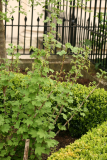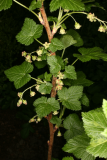Additional notes (click to expand)
Horticulture
There does not appear to be any identifiable record of the red currant in European herbals until the printing of the Mainz Herbariums of 1484. The edition of 1486 has a recognizable woodcut and an account of its medical uses, but no history of its cultivation, and there is similar information in its successor the Hortus Sanitatis, which continued into the beginning of the 16th century. It is not in the manuscript 15th century French herbal Livre des Simples Medicines, nor in the first illustrated English plant book, The Grete Herbal of 1529. However, by the mid-16th century Ribes were being grown in gardens, as borders for flower beds and garden paths, in Germany, as recorded by Leonard Fuchs in 1542, in what is now Belgium by Rembert Dodoens in 1554, and in England by William Turner in 1568. Henry Lyte in England in 1578 calls them ‘red, beyond the sea gooseberries’ and ‘Bastard Corinthes’ as well quoting the continental names of Grossularia rubra, Grossularia transmarina, Ribesium and Ribes rubrum.
Dayan, T. (2018). Notes from Professor Tony Dayan's podcast, March 2018. Professor Tony Dayan.
This red currant has a distinctive, slightly tart flavour and they have a comparatively short season, around midsummer. Red currents prefer a sunny site and a rich, moisture retentive soil. Plant in autumn to early spring at intervals 1.2- 1.5m apart. Mulch in spring with well-rotted organic matter. Propagate from hardwood cuttings taken in early autumn.
Bird, R, Houdret, J. (2000). Kitchen and Herb Gardener. Lorenz. p.274
Birds, which are likely to attack both the buds and fruit, are likely to be the biggest problem. Aphids and black currant gall mites may also be a problem. Grey mould may be a problem and coral spot can affect the branches.
Bird, R, Houdret, J. (2000). Kitchen and Herb Gardener. Lorenz. p.274
Ribes rubrum 'Rovada' is self-fertile with large fruits. A late-fruiting red currant with an excellent flavour. It is a bushy variety that produces a cascade of small bright red fruits from late July onwards. Grows to 1.2m high by 1.5m wide.
Medicinal
Red currants became established in pharmacy as a fruit and sugar drink by appearing in 1498 in the pharmacopoeia of the city of Florence, the Nuovo Receptario; Valerius Cordus’s Dispensatory in 1546; the Augsburg pharmacopoeia of 1564, known as the Augustana, and subsequently in other books, including the Pharmacopoeia Londinensis published by the Royal College of Physicians in 1618. In Linnaeus’s Materia Medica of 1782 the uses of Ribes rubrum were little changed as treatment for fevers, decay, thirst and anger.
Dayan, T. (2018). Notes from Professor Tony Dayan's podcast, March 2018. Professor Tony Dayan.
From the medicinal viewpoint all these works say much the same things - that red currants are good for diarrhoea, vomiting and fevers, stimulating appetite and satisfying thirst, and that the black ones have no medicinal value. The latter can be stored in their own juice, in sugar, or dried in the sun, so they can be eaten year round. Their description as ‘Beyond the sea’ ‘in French, Dutch and Italian books of this period indicates their recent arrival in Europe. Early attempts to link them to plants described by Galen in Rome in the second century AD and by Serapion the Elder from Syria in the 9th century were soon abandoned.
Dayan, T. (2018). Notes from Professor Tony Dayan's podcast, March 2018. Professor Tony Dayan.
The fruit is antiscorbutic, aperient, depurative, digestive, diuretic and a laxative. The leaves contain the toxin hydrogen cyanide. A concoction of the leaves is used externally to relieve rheumatic symptoms. They are also used in poultices to relieve sprains or reduce the pain of dislocations.
Plants for a Future (2018) (http://www.pfaf.org/) https://www.pfaf.org/user/Plant.aspx?LatinName=Ribes+rubrum
Nomenclature
Their English name ‘Currant’ for their fruits, instead of the pan-European name of Ribes, is a relatively recent invention being first used as ‘Currans’ by John Parkinson in 1629 in Paradisi in Sole and applied because of their overall resemblance in the size and shape of the dried fruits if not in colour or taste to the raisins imported from Corinth and Zante as ‘Currants’, a term which had been in use since 1334, when it appeared as ‘Raisins of Courants’ – a corruption of Corinth.
Dayan, T. (2018). Notes from Professor Tony Dayan's podcast, March 2018. Professor Tony Dayan.
Other use
Used as decoration on cakes and in a wide range of desserts and savoury dishes.
Bird, R, Houdret, J. (2000). Kitchen and Herb Gardener. Lorenz. p.274
Phytochemistry
Red currants contain pectin, proanthocyanins and anthocyanin pigments, diterpenes and many phenolic compounds, as well as flavonoids and typical short chain fruit acids. The phenolics and the pigments are the basis of the antioxidant activity of the fruits and have led to unsubstantiated claims of anti-atheroma and other beneficial activities.
Dayan, T. (2018). Notes from Professor Tony Dayan's podcast, March 2018. Professor Tony Dayan.
Toxicity
The leaves contain the toxin hydrogen cyanide.
Plants for a Future (2018) (http://www.pfaf.org/) https://www.pfaf.org/user/Plant.aspx?LatinName=Ribes+rubrum
Podcast
Ribes rubrum 'Rovada'
Family: GROSSULARIACEAEGenus: Ribes
Species: rubrum
Cultivar: 'Rovada'
Common names: Red current
Pharmacopoeia Londinensis name: Ribes
Habit: Shrub
Hardiness: H5 - Hardy; cold winter
Habitat: Moist woodland and riverbanks
Garden status: Not currently grown
Flowering months: April, May
Reason for growing: Medicinal, other use
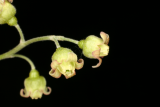
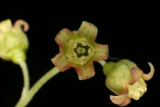
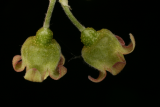
.JPG)
